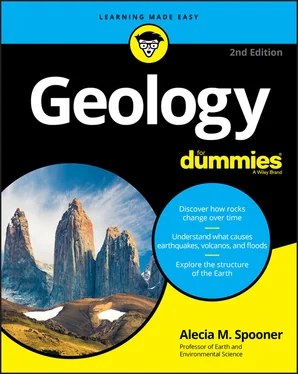Catastrophe Strikes Again and Again
When early geologists looked at the mountains, valleys, and seas around them, they realized that something dramatic must have occurred to create what they saw. Because people believed that the earth was only a few thousand years old, the only way to explain what they saw was by assuming the occurrence of occasional catastrophic events, such as massive floods, volcanic eruptions, and earthquakes.
 This early belief that earth’s features were created by a series of catastrophic events is called catastrophism.
This early belief that earth’s features were created by a series of catastrophic events is called catastrophism.
Geologic explanations involving dramatic, worldwide, catastrophic events were in sync with stories from the Bible, such as the great flood. In this way, catastrophism reconciled strong biblical beliefs with explanations of geologic processes that scientists now know occur over many hundreds of thousands (or even millions) of years.
Early Thoughts on the Origin of Rocks
While catastrophism attempted to explain the creation of earth’s features, questions about the origin of earth’s rocks remained. Where did the rocks on the crust of the earth come from before they were subjected to the catastrophes that shaped and shifted them?
 Two theories dominated early thoughts on the origin of rocks: Neptunism and Plutonism.
Two theories dominated early thoughts on the origin of rocks: Neptunism and Plutonism.
Neptunists proposed oceanic origins. The Neptunist theory of rock origins proposed that all the rocks on Earth were created from sea water, having crystallized from the earth’s first oceans. (The theory is named after the Roman god of the sea, Neptune.)
Plutonists proposed volcanic origins. The Plutonists believed that all Earth’s rocks originated from volcanoes and were then changed by pressure and heat into other rocks. (The theory is named after the Roman god of the underworld, Pluto.)
 While neither of these theories accurately explains how all rocks are formed, each contains partial truths. Some rocks do precipitate from ocean water, some rocks do form from volcanoes, and many rocks are changed into other rocks through heat and pressure, as you discover in Chapter 7.
While neither of these theories accurately explains how all rocks are formed, each contains partial truths. Some rocks do precipitate from ocean water, some rocks do form from volcanoes, and many rocks are changed into other rocks through heat and pressure, as you discover in Chapter 7.
Developing Modern Geologic Understanding
In this section, I introduce three of the most prominent geologists of the seventeenth and eighteenth centuries and describe the theories they proposed: theories that stand up to current scientific scrutiny and still form the basis for modern geologic understanding.
Reading the rock layers: Steno’s stratigraphy
In the mid-seventeenth century, Nicholas Steno, a Danish physician, made great contributions to geology and especially paleontology: the study of fossil life. When Steno began his observations, only a few other scientists had proposed, tested, and attempted to prove that fossils found in rocks were the remains of once-living organisms. Steno advanced these ideas through observations and the study of rocks. His work led him to other questions, such as how could any solid object (a rock, mineral, or fossil) become trapped within another solid object, such as a rock?
 Steno is considered the father of modern stratigraphy, which is the study of layers of rock. He described four principles of stratigraphy that still hold true today:
Steno is considered the father of modern stratigraphy, which is the study of layers of rock. He described four principles of stratigraphy that still hold true today:
Principle of superposition: States that in an uninterrupted sequence of sedimentary rocks (those composed of pieces of other rocks; see Chapter 7), the rock layers below are older than the rock layers above (as long as they have not been deformed, which I describe in Chapter 9). In Figure 3-1, the principle of superposition indicates that layer A is older than layer B, C, or E.
Principle of original horizontality: States that sediments forming sedimentary rocks are usually laid down in a horizontal position (due to gravity). Therefore, rock layers that appear vertical have been moved from their original, horizontal position by some natural force (such as an earthquake).
Principle of lateral continuity: States that when sediments are laid down, creating sedimentary rocks, they spread out until they reach some other object that confines them. This principle is illustrated when you fill your bathtub with water. The water spreads to fill all the space, confined only by the edges of the tub. Pour that same amount of water on the bathroom floor, and it spreads out until it hits the bathroom walls. Sedimentary rocks, like water, continue laterally until they are stopped by some other object.
Principle of cross-cutting relationships: States that where one type of rock cuts across or through another type of rock, the rock being cut is older and the rock cutting through is younger. After all, a rock must already exist in order to be cut through by another rock. This principle is illustrated in Figure 3-1 where rock unit D is younger than the rocks A, B, and C that it cuts through.

FIGURE 3-1:In this sketch of rock layers, the oldest is A, and the youngest is E.
These things take time! Hutton’s hypothesis
While Plutonists and Neptunists were arguing about the origin of Earth’s rocks, Scottish physician James Hutton was observing the rocks in his native Scotland and thinking about the different rock types and rock layers. He proposed theories about their relationship to one another and how current rock formations came to be.
FINDING SHARKS’ TEETH ON MOUNTAINTOPS
Nicholas Steno scientifically examined the head of a shark and reported that the teeth in the shark’s head were very similar to stones found in the mountains. These stones were called glossopetrae, or “tongue stones,” and at the time were believed to result from lightning strikes. Indeed, what Steno had discovered was that sharks’ teeth were actually buried in the rocks on the mountaintop!
 Through his observations of sites such as Siccar Point — a rocky area along the east coast of Scotland — Hutton began describing geologic processes that required long periods of time to create the rock formations visible today. He was the first geologist to propose the idea of geologic time, also called deep time, which extended the age of the earth much farther into the past than had previously been accepted.
Through his observations of sites such as Siccar Point — a rocky area along the east coast of Scotland — Hutton began describing geologic processes that required long periods of time to create the rock formations visible today. He was the first geologist to propose the idea of geologic time, also called deep time, which extended the age of the earth much farther into the past than had previously been accepted.
According to Hutton, with a long enough period of time, even the small, commonplace processes that shape the earth’s surface today could result in the dramatic formations previously assumed to be the results of catastrophe.
What has been will be: Lyell’s principles
Following Hutton’s work, Charles Lyell, a Scottish professor of geology in the early nineteenth century, published a book called Principles of Geology. In this book Lyell outlined and expanded on Hutton’s ideas about deep time, geologic processes, and the formation of rock features on Earth’s surface.
Читать дальше

 This early belief that earth’s features were created by a series of catastrophic events is called catastrophism.
This early belief that earth’s features were created by a series of catastrophic events is called catastrophism. While neither of these theories accurately explains how all rocks are formed, each contains partial truths. Some rocks do precipitate from ocean water, some rocks do form from volcanoes, and many rocks are changed into other rocks through heat and pressure, as you discover in Chapter 7.
While neither of these theories accurately explains how all rocks are formed, each contains partial truths. Some rocks do precipitate from ocean water, some rocks do form from volcanoes, and many rocks are changed into other rocks through heat and pressure, as you discover in Chapter 7.











